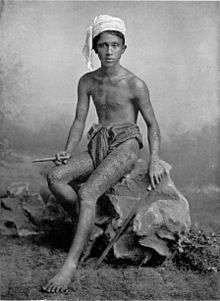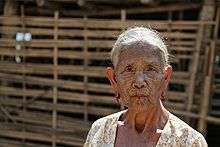Tattooing in Myanmar

Tattooing in Burma was a widespread custom practiced by various ethnic groups, including the Bamar, Shan, and Karen, until the 20th century. Tattooing was a distinguishing cultural marker. For instance, the Arakanese people who are related to the Bamar did not practice tattooing.[1] Similarly, the Mon people did practice tattooing, but did not tattoo their thighs unlike the Bamar.[2]
Origins
Among the Bamar, the custom of tattooing originates from the Shan people, who believed that tattoos had magical or spiritual connotations, used in a similar manner as amulets and protective charms.[3] This practice coincided with the Shan States' control of Upper Burma from the 14th to 17th centuries, as the Shan, themselves tattooed, introduced this practice to the Bamar.[4]
However, with the onset of colonial rule in Burma, the practice of tattooing quickly became extinct, particularly in Burmese towns.[4] During the 1930s, tattooing saw a resurgence in popularity among rebels who participated in peasant and millennial uprisings.[5] Men tattooed themselves to provide immunity to bullets and knives.[5] The practice of tattoo is regaining popularity among Burmese youth.[6]
Pigments
Burmese tattoo pigments traditionally used diluted red mercury sulphide and soot from an oil lamp.[7] For black pigments, the soot was mixed with the dried gallbladder of fish or cattle in powder form, boiled in water and simmered with the leaves of bitter melon.[7] A product was reduced to paste form and dried until usage.[7] A greenish tinge was produced by dabbing the pierced areas of the skin with leaves of Senna siamea or Brugmansia suaveolens.[7]
Tattooing among men
Nearly all Bamar men were tattooed at boyhood (between the ages of 8 and 14),[8] from the waist to the knees.[9] The tattooed patterns were ornamented pastiches of arabesques and animals and mythical creatures, including cats, monkeys, chinthe, among others.[1] For the Bamar, tattooing of the waist, done with black pigment, was done before or soon after temporary ordination into monkhood, a major rite of passage for men.[1] Other parts of the body were tattooed with red pigments.[1] Among the Shan, blue or red pigments were especially popular, as were charms and cabalistic figures similar to yantra tattoos.[8][10]
Tattooing was a painful procedure that required extensive use of opium used as a painkiller.[8] A professional tattoo artist (မှင်ကြောင်ဆရာ or ကွင်းဆရာ) used a hnitkwasok, a long two-pronged brass or iron instrument with a 2 inches (51 mm) slit similar to a double-pointed pen, to pierce the skin.[1][8] Completion of the tattoos took from 3 to 6 days.[8]
Tattooing among women

Southern Chin women were also tattooed on their faces with closely set lines using blue pigments, ostensibly to discourage them from being kidnapped by invaders.[11] Chin women were typically tattooed between the ages of 15 and 20.[12] The practice has quickly disappeared, as it was banned in the 1960s by Burma's socialist regime and it was discouraged by Christian missionaries.[13][14] Mro women also wore tattoos in the form of small marks or stars on the cheek, forehead or breast.[1]
References
- 1 2 3 4 5 6 Gait, Edward Albert (1902). Census of India, 1901. 12. Office of the Superintendent of Government Printing.
- ↑ Lieberman, Victor B. (1978). "Ethnic Politics in Eighteenth-Century Burma". Modern Asian Studies. Cambridge University Press. 12: 455–482. doi:10.1017/s0026749x00006235.
- ↑ Paquette, David (February 2008). "Tattoo not Taboo". The Irrawaddy. Retrieved 27 September 2013.
- 1 2 Cochrane, Henry Park (1904). Among the Burmans: A Record of Fifteen Years of Work and Its Fruitage. Judson Press.
- 1 2 Tarling, Nicholas (1998). Nations and States in Southeast Asia. Cambridge University Press. p. 110. ISBN 9780521625647.
- ↑ Maung, Manny (24 June 2013). "Inked for life". Myanmar Times. Retrieved 27 September 2013.
- 1 2 3 4 Thanegi. "Tattoo Traditions in Myanmar". Enchanting Myanmar. Retrieved 27 September 2013.
- 1 2 3 4 5 The Baptist Missionary Magazine. 51-52. American Baptist Foreign Mission Society. 1871. pp. 107–108.
- ↑ Balfour, Edward (1885). The Encyclopædia of India and of Eastern and Southern Asia. 2. Harvard University. p. 291.
- ↑ Scott, James George (1910). The Burman: his life and notions. Macmillan and Co. pp. 39–47.
- ↑ White, Herbert Thirkell (2011). Burma. Cambridge University Press. ISBN 9781107600676.
- ↑ Myo Myo. "A symbol of Chin identity fades away". Myanmar Times. Retrieved 27 September 2013.
- ↑ "Tattooed Chin women lure tourists to remote region". Myanmar Times. 25 April 2011. Retrieved 27 September 2013.
- ↑ Nyein Ei Ei Htwe (17 November 2013). "Chin tattoos: a fading tradition". Myanmar Times. Retrieved 1 July 2015.